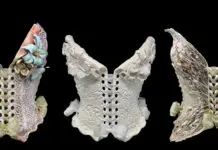Tulsa’s GWACS Defense, Inc. will change ground warfare forever. Friendly fire. Protracted skirmishes in urban settings. These problems go away with the application of its inventive and new technology, the Ground Warfare Acoustible Combat System. Its innovative approach to tracking hostile fire in a combat situation takes the guesswork out of ground troops’ responses, making otherwise hairy combat situations easier to resolve – with less casualties. The five-year-old company is already ringing bells in Washington with its solution to a problem that’s been plaguing the Pentagon for decades.
Shel Jones, the company’s vice president of business development, served 23 years in the U.S. Army and is deeply familiar with the problem. But the idea for the system didn’t originate in combat.
“The owners of the company had a technology that could identify gunfire detection. The Virginia Sniper incident a few years ago created the motivation to use acoustics to compute the point of origin of hostile fire. Since then the technology’s matured, and the threats to our forces overseas made ground combat seem like a logical direction to pursue,” says Jones.
The system works by deploying a one-pound “man-wearable” computer on each member of a team or platoon responding to a hostile situation. Unlike other gunshot detection systems that rely on a single sensor, multiple deployment means more sources of reference. And they’re spread out across the combat area. GWACS processes the information on a “netted” system, allowing quick triangulation of a threat. All units share the same processor, allowing it to process location data on one computer and provide instant feedback to troops on the ground. This means getting a faster bead on the bad guy, reducing response time and making the situation safer for the troops. It also transmits information to off-site operation commanders, letting them know immediately that their troops are in harm’s way.
The company is actively pursuing other applications to make police work safer. Says Jones, “We’ve pursued different styles of gunshot detection and location in different styles. We’ve looked into it as something that could be put on an entire police squad, thus stretching the sensor array across the formation so that not just one individual understands where the hostile fire comes from. Every individual in the squad sees it. The acoustic array is spread across a farther distance. More samples contribute to the solution. Our system is very accurate in urban environments.” The device is in its fourth generation, and May will bring a final version.
Understanding where hostile fire comes from is not easy for the human senses. The sonic crack of a gun is often perpendicular to the muzzle blast. Given echoes and other background noise, those being shot at spend quite a bit of time looking for where that threat came from because a combat environment is noisy and chaotic. Sometimes a soldier doesn’t know he’s being shot at. The system shortens the reaction time and enables an entire platoon to hone in on a hostile fire event, as opposed to one individual guessing where the sniper is, getting on their radio and informing allies. The confusion is lessened. The reaction time is faster and the threat is minimized.
GWACS also hopes to place its system in helicopters, other vehicles and public venues such as stadiums. In the event of a threat at, say, the Super Bowl, the system would allow security to locate and apprehend a gunman quickly, saving lives and avoiding what could be a disaster that would haunt front page headlines for weeks.
The company’s not just making a profit. It’s also seeing a significant tax break by participating in Oklahoma’s 21st Century Quality Jobs Act. The law is aimed at keeping high-quality technology jobs in Oklahoma. The state provides tax breaks against payroll for GWACS’s maintenance of an average salary for engineers of $94,000 per year. And the company has a seven-year plan to ramp up to 54 engineers.
Jones believes the tax break is well-deserved. The state’s not just investing in companies, it’s investing in its university graduates.
“The software and hardware was developed by engineers that live in Oklahoma. The majority of our people graduated from Oklahoma universities. I may be the only member of the company new to Oklahoma. And I’m glad to be, by the way. My family loves it here,” says Jones.
“In five years our company will grow dramatically as our man-wearable product line expands into vehicle, helicopter, and fixed site applications for Department of Defense, Homeland Security, law enforcement and commercial markets with a version of the man wearable product specifically designed for outdoorsmen and hunters,” says Jud Gudgel, president of GWACS.


























